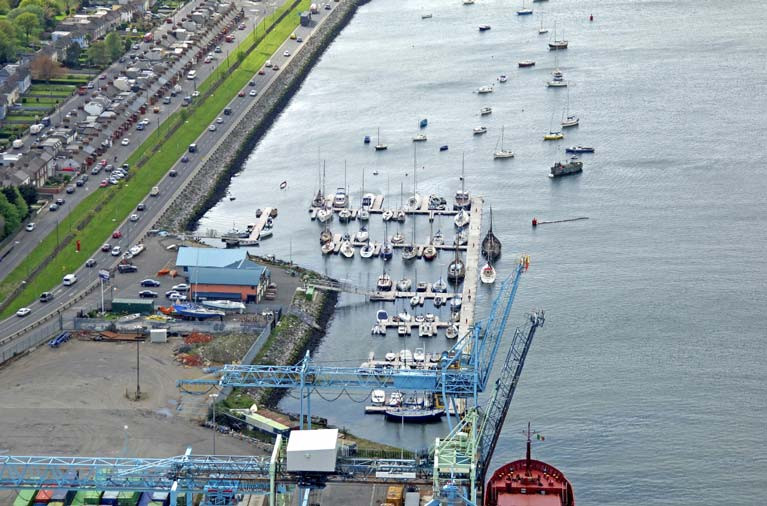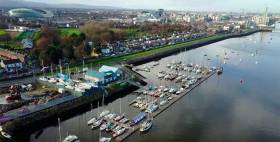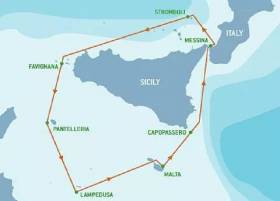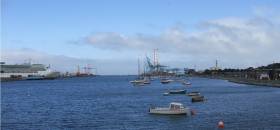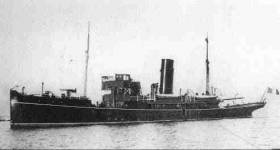Displaying items by tag: Poolbeg Yacht and Boat Club
Flotilla Gathers for Poolbeg Yacht and Boat Club's 'Blessing of Boats' Ceremony on Dublin's River Liffey
Up to 30 yachts and motorboats joined the annual Poolbeg Yacht and Boat Club parade of sailing down the River Liffey and out into Dublin Bay on Sunday afternoon, a tribute to deceased members of the Dublin City club.
The strong turnout preceded the annual blessing of the boats at the club's marina, which was officiated by Fr Ivan Tonge, who also recently blessed a new coastal rowing skiff for the neighbouring Stella Maris Rowing Club.
 The annual blessing of boats took place on Sunday, 12th May 2024 at Poolbeg Yacht and Boat Club premises and was officiated by Fr Ivan Tonge of Ringsend Photo: Afloat
The annual blessing of boats took place on Sunday, 12th May 2024 at Poolbeg Yacht and Boat Club premises and was officiated by Fr Ivan Tonge of Ringsend Photo: Afloat
The annual blessing of the boats is a time-honoured tradition which dates back many centuries with some origins traced back to the early fisherman of the Liffey.
 (Above and below) Up to 30 yachts and boats were dressed overall for a multi-coloured parade of sail on the River Liffey as part of the annual blessing of the boats ceremony at Poolbeg Yacht and Boat Club Photo: Afloat
(Above and below) Up to 30 yachts and boats were dressed overall for a multi-coloured parade of sail on the River Liffey as part of the annual blessing of the boats ceremony at Poolbeg Yacht and Boat Club Photo: Afloat

Events in ports around the world can range from a simple ceremony to a multi-day festival including church services, parades, dancing, feasting and contests.
A sudden rain shower and the departure of both Stena Estrid and Irish Ferries Oscar Wilde only momentarily paused the 2024 multi-coloured parade.
 The parade of Sail waits for Irish Ferries Oscar Wilde to depart Dublin Port Photo: Afloat
The parade of Sail waits for Irish Ferries Oscar Wilde to depart Dublin Port Photo: Afloat
A wreath in honour of deceased members of the club was laid out at the mouth of the Liffey in choppy Dublin Bay conditions.
One such member remembered fondly is former club commodore and proud Ringsender John Wedick who died last November as Afloat paid tribute here
 (Above and below) Once into Dublin Bay, wreaths were laid in Dublin Bay for deceased PYBC members via a flotilla of vessels Photo: Afloat
(Above and below) Once into Dublin Bay, wreaths were laid in Dublin Bay for deceased PYBC members via a flotilla of vessels Photo: Afloat


The flotilla returned to the club for a PYBC committee food and wine reception and the lovely prospect of a fun-filled 2024 summer boating season ahead.
Meanwhile, an agreement has been secured on a new Maritime Village Community proposal in the area as part of Dublin Port's update on its 3FM Project as Afloat reports here
Poolbeg Yacht and Boat Club Blessing of Boats 2024 Photo Gallery By Afloat
Revised Edition of Northabout Published by Jarlath Cunnane
Polar circumnavigator, sailor and boat builder Jarlath Cunnane is marking the publication of a revised edition of his book, Northabout, in Dublin’s Poolbeg Yacht and Boat Club next week.
Cunnane and crew became the first small yacht to complete the most challenging east-west circumnavigation of the Arctic ice cap almost two decades ago.
His book with stunning photographs records the voyage in the 47ft aluminium yacht he built, taking place over several winters – with Northabout eventually returning to Cunnane’s home county of Mayo in October 2005.
Before that expedition, Cunnane, Paddy Barry and sailing companions attempted in early 1997 to replicate Ernest Shackleton’s extraordinary 800-mile Antarctic voyage from Elephant Island to South Georgia. Cunnane built a replica of the small lifeboat, the James Caird, and has recently completed another such build during Covid-19.
Jarlath will be showing a short film on the night of Northabout’s transit through the White Sea Canal.
The event at Poolbeg Yacht and Boat Club takes place on December 21st at 8 pm.

Dublin Bay Old Gaffers Association Holds 2022 AGM at Poolbeg In Dublin Port
The Dublin Bay Old Gaffers Association is now the central organisation for the OGA in Ireland, following the absorption of the Northern Ireland branch, which supplied the re-elected President, Adrian "Stu" Spence.
His home port is in Ringhaddy Sound in Strangford Lough, but on Saturday, he brought together an Annual General Meeting in Dublin Port which reflected the all-Ireland nature of the DBOGA despite its apparently location-specific title, and the election of a large committee further reflected the gathering's countrywide interests.
Honorary Secretary Darryl Hughes of Crosshaven stood down after several years of sterling service, which included steering the Association through the Pandemic in a busy style with a comprehensive series of Zoom sessions involving a wide range of maritime topics, while combining a successful ongoing fund-raising drive for the Howth lifeboat
Darryl is succeeded by Peter Tobin as Secretary, while Dave Neilly takes over from Jimmy Murphy as Treasurer as the DBOGA heads into a busy 2023, which will include the extensive celebrations of the now-international Old Gaffers Association's 60th Anniversary.
The 2023 DBOGA Officers & Committee are:
Adrian Spence - President
Peter Tobin - Secretary
Dave Neilly - Treasurer
Committee:
Dennis Aylmer (Dun Laoghaire)
John Elston
Joe Foley
John Ferguson
Negley Groom (Poolbeg)
Darryl Hughes (Crosshaven)
Gerry Keane
Paul Keogh (Clondalkin)
David Lewis
Cormac Lowth
Ed Maggs (Kerry)
Jimmy Murphy
Paul Rowe
Mark Sweetnam
Chris Trevithick
Seán Walsh (Kinsale)
Johnny Wedick
Michael Weed (Donegal)
A recording of the AGM is below
Poolbeg Yacht & Boat Club Cancels Annual Lift-In of Boats
Dublin's Poolbeg Yacht and Boat Club has asked berth holders not to 'quarantine' or 'isolate' on their boats at the city-centre marina.
The advice comes as the River Liffey club also cancelled its annual lift-in boat boats until further notice because of the Covid-19 emergency.
The marina and clubhouse has been closed in line with government guidelines and the club has asked visitors not to arrive at the marina until further notice.
In a letter to members, the PYBC committee said 'although it goes against everything we stand for, we have to ask our customers to keep away from Poolbeg Marina until the situation improves'.
Poolbeg Yacht and Boat Club’s annual regatta will take place this coming bank holiday weekend during the Dublin Port’s Riverfest! The organisers have apologised for the short notice which was caused by an incident resulting in possible outage of Poolbeg marina facility during the event but this is now rectified.
Racing participants and visiting boats are welcome to Dublin Port’s Riverfest and the Caribbean beach party at PYBC’s annual regatta!
There will be 3 days of racing, shoreside activities and all are encouraged to take a trip up the river Liffey to Poolbeg Yacht and Boat Club where there will be an Urban Beach, live Caribbean Band and much more!
Race participants will be greeted with a free drink and there is food available for purchase on arrival. For visiting boats, please find attached below a Notice to Mariners and the Dublin Port Entry Guide.
Sailing races and activities are divided as follows:
Dublin Bay Racing
Cruiser 1
Cruiser 2
Cruiser 3
White sails and others include the
Irish Sea Offshore Sailing Association (ISORA)
Old Gaffers Association
E Boats
Ruffian 23
River Liffey Racing
Dinghy races for various classes
Ruffian and E Boat Classes - including "try sailing" during the race
Parade of sail demonstrations will take part on the river every day.
Any racing or cruising boat can take part.
PYBC will be broadcasting live an ISORA race on a screen throughout Saturday, the race will begin in Howth Yacht Club, around Lambay Island and finishes in Dublin Port.
Dublin Port: Poolbeg To Lose Its Pontoons? Sandymount To Lose Its Strand?
This is Public Consultation Week for the First Review of Dublin Port’s Development Masterplan 2012-2040, and with a 28-year timespan involved, some of the more remote yet very possible proposals will still seem at the very least far-fetched - and at worst outrageous - to residents and harbour users most directly affected writes W M Nixon.
You’ll need to get your skates on if you’re going to see how the port is presenting its proposals in the neighbourhoods most directly involved, as the Clontarf session today (Monday 13th February) in Scoil Ui Chonaill GAA was due to conclude at 8.0pm. Tomorrow being St Valentine’s Day, everyone will be otherwise occupied as Dublin is a a city of incurable romantics, but the show resumes on Wednesday 15th February from 2.0pm to 8.0pm at the Sean O’Casey Community Centre, St Mary’s Road, East Wall Road, Dublin 3.
However, it’s the concluding show on Thursday 16th February, again from 2.0pm to 8.0pm, which is likely to attract most sparks, as it’s in Clanna Gael Fontenoy GAA Club, Sean Moore Road, Ringsend, Dublin 4, and it’s the Dublin communities of Ringsend, Irishtown and Sandymount – all in Dublin 4 - which would see some of the more far-fetched proposals having greatest impact.
From a visit to the Clontarf presentation today (Monday) it seems that while the harbour’s development seawards is now being handled in a way which has assuaged the worst fears of Clontarf residents, it is Dublin Port’s determination to maintain a strong and growing presence south of the river which could permanently change life for people in Ringsend and Sandymount.
With the two parts of the port connected only by the East Link Lifting Bridge, this is an almost permanent traffic bottleneck, so it’s not surprising that a proposal expecting early implementation is a new bridge immediately east of the East Link.
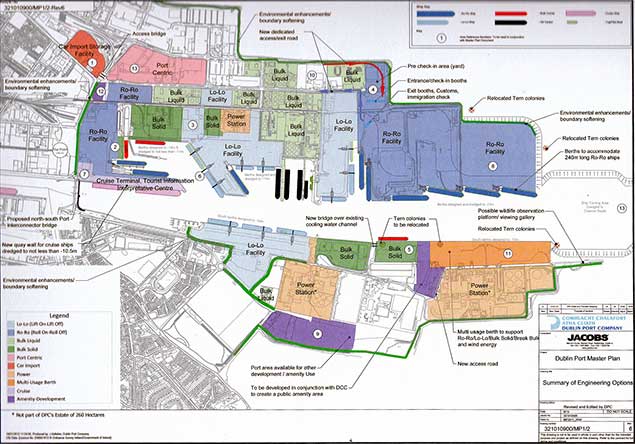 Connections between the north and south parts of the port are always under strain, and an early proposal was the installation of a second bridge immediately eastward of the present East Link Bridge
Connections between the north and south parts of the port are always under strain, and an early proposal was the installation of a second bridge immediately eastward of the present East Link Bridge
At the moment this parallel bridge seems to be proposed as a link exclusively for port traffic. But if that is the case then new road capacity has to be provided from the new bridge eastward to Poolbeg Roundabout, so an alternative scenario is that the new bridge be paired with the existing East Link to provide a dual carriageway, which in turn will be continued to the Poolbeg Roundabout.
Providing such a dual carriageway will inevitably take a chunk out of the space at present used by Poolbeg Yacht & Boat Club both on the land and in their marina too. So instead of a compact marina clustered at the club, one variation of the plan shows an elongated marina running virtually the whole way to the new bridge immediately seaward of the northern lane of a the new dual carriageway.
However, while this may lessen the East Link bottleneck, most of the traffic using the East Link is not port-related anyway. They’re just people deluded by the notion that they’re taking the quickest way from the North City – and particularly the airport – to the vast affluent swathes of the south county. They arrive smoothly at the East Link via the Port Tunnel, and now if the East Link to Poolbeg Roundabout section become effectively a mini-motorway, they’ll be further deluded until they find themselves back in old-fashioned traffic jams as they try to make their way towards Sandymount Strand.
 Hints of how the port might be. A new fixed bridge has been built across the mouth of the Dodder on the South Bank immediately upriver of the Eastlink, thereby cutting off access to the Grand Canal Basin for all but “canal boats”, while the line of red-and-white dots is the suggested route of the Eastern By-pass, which seems to be sent off from the Poolbeg Peninsula into the wide open spaces of Sandymount Strand.
Hints of how the port might be. A new fixed bridge has been built across the mouth of the Dodder on the South Bank immediately upriver of the Eastlink, thereby cutting off access to the Grand Canal Basin for all but “canal boats”, while the line of red-and-white dots is the suggested route of the Eastern By-pass, which seems to be sent off from the Poolbeg Peninsula into the wide open spaces of Sandymount Strand.
So the old monster which just won’t go away, the Eastern Bypass, raises its head again in the proposals relating to the more distant future, though “distant” is only relative – 28 years is no time at all. Be that as it may, the cheapest option for an Eastern By-pass is a motorway-standard dual carriageway along Sandymount Strand, upon the completion of which, the next discussion will be where it re-joins the city’s road system.
But that’s an argument for another day which may not be necessary if another line of thought is taken, to which we’ll come in a minute. But right now, whatever happens, there’s no doubting that the cosy setup at Poolbeg, with a friendly club with a strong sense of community, and it all handy to the city, is under threat.
In fact, sometimes when you see ships manoeuvring within feet of the delicate marina structure in a real breeze of wind, you can’t help but think that you are watching a YouTube “Best Ship Disasters” vid in the making, and that Poolbeg Marina’s continued existence is a little miracle.
 It can be quite thought-provoking to see ships being manoeuvred in a breeze of wind within a stone’s throw of Poolbeg Marina. Photo: W M Nixon
It can be quite thought-provoking to see ships being manoeuvred in a breeze of wind within a stone’s throw of Poolbeg Marina. Photo: W M Nixon
So the Poolbeg contingent are planning to be there in strength on Thursday to see for themselves just what the future might hold, and among other things they’ll see confirmation that a bus-lane-and-pedestrian bridge is highly likely across the mouth of the Dodder, thereby cutting off access to the Grand Canal Basin for vessels with masts or even just exceptional top hamper – the only reassurance I could get was that “canal boats” will have sufficient clearance.
As for the Eastern Bypass, if the cheapo version along the beach is built, then Sandymount will indeed have lost its strand. At the moment, the little coastal road is something you can walk across at any point, and the seashore seems very accessible. But as soon as you get eastward of Merrion Gates, the railway is defining most of the shoreline, and the sense of the sea being accessible is no longer so apparent – who ever talks of Booterstown Beach?
A motorway along the beach is every bit as much of a barrier as a railway, so it would be the end of Sandymount Strand as thousands know and love it. But anyway, if such a road were built, it would only deliver people further along the line into another jam. To make sense, it would have to go all the way to the nearest part of the M50/M11 linkup, which is somewhere about Leopardstown. Yet there’s just no way a raw new motorway is going to be built across this unrivalled area of prime real estate. However, north of the river the Port Tunnel is merrily working away, doing its work so well we almost forget it exists. Yet it seemed impossibly grandiose at the time it was first proposed.
A Ringsend to Leopardstown Tunnel would be about three times as long, and it would need at least two interchanges built into it to make logistical sense. But it is certainly well within the scope of fairly basic tunneling technology. And up in Arranmore in Donegal, there’s inherited tunneling expertise from the time of building the Channel Tunnel between England and France. The Arranmore economy would find the Ringsend-Leopardstown Tunnel a very nice little earner, thank you. And with some clever planning, it could leave the communities of Ringsend, Irishtown and Sandymount largely intact.
#Lecture - Glenua & Friends presents a lecture: Rolex Middle Sea Race 2015 - How Malahide Father & Son Won the Double-handed Division.
The talk by Dermot Cronin takes place next Thursday 13 October at 20:00 in Poolbeg Yacht & Boat Club Ringsend. Entry €5 (in aid of RNLI)
The Annual 608 mile Rolex Middle Sea Race is the Mediterranean equivalent of the Fastnet.
Every October it attracts a large international entry to Valetta in Malta, the starting point of the 608 mile race where skippers and crew experience a diversity of landscape and varying sea conditions defined by frustrating light airs to sail-splitting storms.
In his illustrated lecture, Dermot Cronin of Malahide Yacht Club, will bring us the inside story of how his son Paddy and himself won the Double-handed division of the 2015 Middle Sea Race in their yacht Encore, a First 40.7.
Apart from the tactical challenges, it was an energy–sapping race with frequent sail-changing and variable winds reaching 42kts+.
Ever since his first sailing course with Glenans in Bere Island in 1979, racing around islands has attracted Dermot. Being an active racing member of Malahide Yacht Club since 1989, he progressed to Round Ireland racing, D2D’s and Fastnet in 2003.
In Encore he headed for Malta where he raced the Middle Sea Race in 2013 and 2014 fully crewed. His son Paddy has won the Round Ireland Double-handed division twice along with the RORC UK equivalent. Thus father and son teamed up in October 2015 for Double-handed division of the Middle Sea Race.
Poolbeg Yacht Club Host it’s First Ever Dinghy Open Event: RS King of the Liffey Sprint
Poolbeg Yacht and Boat Club hosts it’s first ever dinghy open event as part of their annual regatta. The combined RS fleets, the RS200’s & RS400’s, will race the "King of the Liffey Open Sprint Event" on Saturday the 13th of August. Exciting short course racing will be run on the Liffey opposite the ideal spectator vantage point of Poolbeg Yacht Club. Anyone interested in watching some close racing in the city centre is more than welcome!
Whale of a Thought At Poolbeg Yacht & Boat Club
I love an opportunity to call into Poolbeg Yacht and Boat Club, “the real Dublin sailing club,” as I have been told by those fortunate enough to be members. There is always an easy, friendly welcome and a chat. No pretensions to the unnecessary grandeur that has to be endured at some other clubs. “We are the heart of Dublin sailing, proud to be known as the workingmen’s yacht club,” another description given to me of this club which has a particular fondness for traditional boats and has been to the fore in support for such as the Galway hookers and the Old Gaffers, whose residence in the club precincts is a notable endorsement of the hallowed traditions of sailing.
“The only marina and club in the heart of Dublin,” it proclaims and which I reflected upon as a very accurate statement as I drove through Ringsend, whose maritime tradition stretches back centuries and along the South Bank of the Liffey down to Pigeon House Road to the club. On this occasion I was calling to go aboard Celtic Mist, boat of the late Charlie Haughey, on which I had been honoured to carry out the re-launching ceremony when it was taken over by the Irish Whale and Dolphing Group to whom it had been given by the Haughey family.
I hadn’t been aboard since the day of the re-launch at Kilrush in August of 2012. It was on the 25th anniversary voyage marking Ireland’s declaration of a whale and dolphin sanctuary in national waters, made by Mr.Haughey. Celtic Mist was moored on the €1.5m. marina development by the Poolbeg Club which has provided 100 berths close to the city centre.
Fiacc O Brolochain was in charge aboard.
LISTEN to Podcast below.
Celtic Mist left Poolbeg and headed to Howth and then Drogheda for the Maritime Festival, across to the Isle of Man and onto Arklow for the Sea Breeze festival, continuing its 25th anniversary voyage. The IWDG is not happy with the formation of the new Heritage Council which has no member with expertise in wildlife. It says the Council has been reduced by the State to a level where it is “unable to deliver on its natural heritage functions.” The Group is also monitoring a number of unexplained deaths of dolphins off Kerry which local people are blaming on the presence of supertrawlers off the coast. The supertrawler/dolphin bycatch issue has been on-going since early 2014.
Saturday, August 27, has been set by the Whale and Dolphin Group as national Whale Watch Day on 20 headlands around the coast.
Lecture: ‘Maritime Aspects of the 1916 Rising’
#1916maritime - The Winter lecture 2015/16 season of the Glenua Sailing Centre concludes with a lecture entitled: ‘Maritme Aspects of the 1916 Rising’ by Dr Edward Bourke.
The illustrated lectures will take place on Thursday 14 April (20:00hrs) at the Poolbeg Yacht & Boat Club, Ringsend, Dublin. There will be an entry fee of €5 in aid of the R.N.L.I.
Edward Bourke is an industrial microbiologist recently retired from brewery research. He is also maritime historian and has published five books on Irish shipwrecks as well as a history of Guinness. Currently he is working on the role of intelligence during the war of Independence in Ireland.
In his illustrated lecture, Edward will explore several maritime aspects of the 1916 events. Foremost among them being the role played by the Royal Navy in suppressing The Rising by strategic interventions.
He will assess the view that the impact of the Helga is greatly exaggerated on the basis that most of the shelling of Dublin was done by field artillery or whether the import of guns for the Volunteers in 1914 was carefully controlled by the British authorities. How plausible is the opinion that the navy had ample forewarning of the intentions of the Volunteers but allowed the 1916 Rising to proceed?
Edward will also discuss the significance of the 1916 rising in the wider context of the Great European War.


























